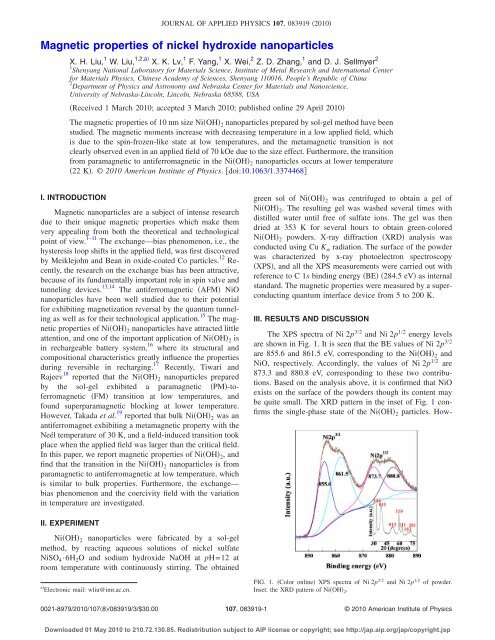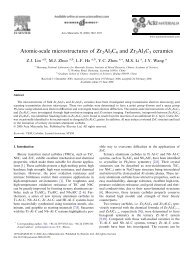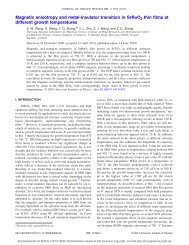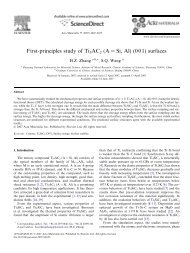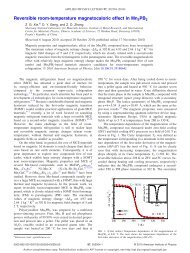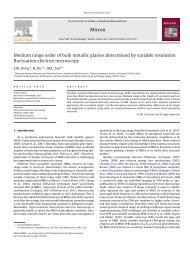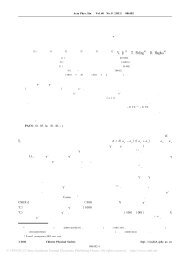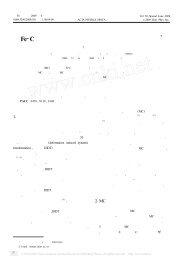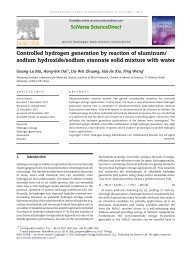Magnetic properties of nickel hydroxide nanoparticles
Magnetic properties of nickel hydroxide nanoparticles
Magnetic properties of nickel hydroxide nanoparticles
Create successful ePaper yourself
Turn your PDF publications into a flip-book with our unique Google optimized e-Paper software.
JOURNAL OF APPLIED PHYSICS 107, 083919 2010<br />
<strong>Magnetic</strong> <strong>properties</strong> <strong>of</strong> <strong>nickel</strong> <strong>hydroxide</strong> <strong>nanoparticles</strong><br />
X. H. Liu, 1 W. Liu, 1,2,a X. K. Lv, 1 F. Yang, 1 X. Wei, 2 Z. D. Zhang, 1 and D. J. Sellmyer 2<br />
1 Shenyang National Laboratory for Materials Science, Institute <strong>of</strong> Metal Research and International Center<br />
for Materials Physics, Chinese Academy <strong>of</strong> Sciences, Shenyang 110016, People’s Republic <strong>of</strong> China<br />
2 Department <strong>of</strong> Physics and Astronomy and Nebraska Center for Materials and Nanoscience,<br />
University <strong>of</strong> Nebraska-Lincoln, Lincoln, Nebraska 68588, USA<br />
Received 1 March 2010; accepted 3 March 2010; published online 29 April 2010<br />
The magnetic <strong>properties</strong> <strong>of</strong> 10 nm size NiOH 2 <strong>nanoparticles</strong> prepared by sol-gel method have been<br />
studied. The magnetic moments increase with decreasing temperature in a low applied field, which<br />
is due to the spin-frozen-like state at low temperatures, and the metamagnetic transition is not<br />
clearly observed even in an applied field <strong>of</strong> 70 kOe due to the size effect. Furthermore, the transition<br />
from paramagnetic to antiferromagnetic in the NiOH 2 <strong>nanoparticles</strong> occurs at lower temperature<br />
22 K. ©2010 American Institute <strong>of</strong> Physics. doi:10.1063/1.3374468<br />
I. INTRODUCTION<br />
<strong>Magnetic</strong> <strong>nanoparticles</strong> are a subject <strong>of</strong> intense research<br />
due to their unique magnetic <strong>properties</strong> which make them<br />
very appealing from both the theoretical and technological<br />
point <strong>of</strong> view. 1–11 The exchange—bias phenomenon, i.e., the<br />
hysteresis loop shifts in the applied field, was first discovered<br />
by Meiklejohn and Bean in oxide-coated Co particles. 12 Recently,<br />
the research on the exchange bias has been attractive,<br />
because <strong>of</strong> its fundamentally important role in spin valve and<br />
tunneling devices. 13,14 The antiferromagnetic AFM NiO<br />
<strong>nanoparticles</strong> have been well studied due to their potential<br />
for exhibiting magnetization reversal by the quantum tunneling<br />
as well as for their technological application. 15 The magnetic<br />
<strong>properties</strong> <strong>of</strong> NiOH 2 <strong>nanoparticles</strong> have attracted little<br />
attention, and one <strong>of</strong> the important application <strong>of</strong> NiOH 2 is<br />
in rechargeable battery system, 16 where its structural and<br />
compositional characteristics greatly influence the <strong>properties</strong><br />
during reversible in recharging. 17 Recently, Tiwari and<br />
Rajeev 18 reported that the NiOH 2 <strong>nanoparticles</strong> prepared<br />
by the sol-gel exhibited a paramagnetic PM-t<strong>of</strong>erromagnetic<br />
FM transition at low temperatures, and<br />
found superparamagnetic blocking at lower temperature.<br />
However, Takada et al. 19 reported that bulk NiOH 2 was an<br />
antiferromagnet exhibiting a metamagnetic property with the<br />
Neél temperature <strong>of</strong> 30 K, and a field-induced transition took<br />
place when the applied field was larger than the critical field.<br />
In this paper, we report magnetic <strong>properties</strong> <strong>of</strong> NiOH 2 , and<br />
find that the transition in the NiOH 2 <strong>nanoparticles</strong> is from<br />
paramagnetic to antiferromagnetic at low temperature, which<br />
is similar to bulk <strong>properties</strong>. Furthermore, the exchange—<br />
bias phenomenon and the coercivity field with the variation<br />
in temperature are investigated.<br />
green sol <strong>of</strong> NiOH 2 was centrifuged to obtain a gel <strong>of</strong><br />
NiOH 2 . The resulting gel was washed several times with<br />
distilled water until free <strong>of</strong> sulfate ions. The gel was then<br />
dried at 353 K for several hours to obtain green-colored<br />
NiOH 2 powders. X-ray diffraction XRD analysis was<br />
conducted using Cu K radiation. The surface <strong>of</strong> the powder<br />
was characterized by x-ray photoelectron spectroscopy<br />
XPS, and all the XPS measurements were carried out with<br />
reference to C 1s binding energy BE 284.5 eV as internal<br />
standard. The magnetic <strong>properties</strong> were measured by a superconducting<br />
quantum interface device from 5 to 200 K.<br />
III. RESULTS AND DISCUSSION<br />
II. EXPERIMENT<br />
NiOH 2 <strong>nanoparticles</strong> were fabricated by a sol-gel<br />
method, by reacting aqueous solutions <strong>of</strong> <strong>nickel</strong> sulfate<br />
NiSO 4·6H 2 O and sodium <strong>hydroxide</strong> NaOH at pH=12 at<br />
room temperature with continuously stirring. The obtained<br />
The XPS spectra <strong>of</strong> Ni 2p 3/2 and Ni 2p 1/2 energy levels<br />
are shown in Fig. 1. It is seen that the BE values <strong>of</strong> Ni 2p 3/2<br />
are 855.6 and 861.5 eV, corresponding to the NiOH 2 and<br />
NiO, respectively. Accordingly, the values <strong>of</strong> Ni 2p 1/2 are<br />
873.3 and 880.8 eV, corresponding to these two contributions.<br />
Based on the analysis above, it is confirmed that NiO<br />
exists on the surface <strong>of</strong> the powders though its content may<br />
be quite small. The XRD pattern in the inset <strong>of</strong> Fig. 1 confirms<br />
the single-phase state <strong>of</strong> the NiOH 2 particles. Howa<br />
Electronic mail: wliu@imr.ac.cn.<br />
FIG. 1. Color online XPS spectra <strong>of</strong> Ni 2p 3/2 and Ni 2p 1/2 <strong>of</strong> powder.<br />
Inset: the XRD pattern <strong>of</strong> NiOH 2 .<br />
0021-8979/2010/1078/083919/3/$30.00<br />
107, 083919-1<br />
© 2010 American Institute <strong>of</strong> Physics<br />
Downloaded 01 May 2010 to 210.72.130.85. Redistribution subject to AIP license or copyright; see http://jap.aip.org/jap/copyright.jsp
083919-2 Liu et al. J. Appl. Phys. 107, 083919 2010<br />
FIG. 2. Color online Temperature dependences <strong>of</strong> ZFC and FC magnetization<br />
in applied field <strong>of</strong> 0.1 kOe. Inset: the ac susceptibility vs temperature.<br />
ever, the diverse peaks having very different peak width<br />
found in XRD pattern may be due to stacking faults in the<br />
material. 20 As the 100 peak is not affected by stacking fault<br />
broadening, the grain size <strong>of</strong> the sample was determined to<br />
be about 10 nm by the Scherrer formula, 21 which could approximately<br />
represent the average grain size <strong>of</strong> the sample.<br />
Temperature dependences <strong>of</strong> zero-field-cooling ZFC<br />
and field-cooling FC magnetization in a magnetic field <strong>of</strong><br />
0.1 kOe are shown in Fig. 2. The inset in Fig. 2 presents the<br />
ac susceptibility versus temperature. It is clear that the ZFC<br />
magnetization increases and reaches a maximum at 22 K,<br />
and then decreases with increasing temperature. Furthermore,<br />
the versus T curve shows the peak at 22.5 K, which<br />
is in agreement with the ZFC curve. In order to investigate<br />
the variation in magnetization with applied field, the ZFC-FC<br />
curves in applied fields <strong>of</strong> 1, 10, and 50 kOe are shown in<br />
Fig. 3. It can be seen that the bifurcate points <strong>of</strong> the magnetization<br />
curves decrease with increasing applied field. Furthermore,<br />
the slopes <strong>of</strong> the FC curve increase with increasing<br />
the applied field below the temperature corresponding to the<br />
peak, and the value <strong>of</strong> slope changes from negative at a small<br />
FIG. 3. Color online Temperature dependences <strong>of</strong> ZFC and FC magnetization<br />
curves in applied field <strong>of</strong> 1, 10, and 50 kOe. Inset: ZFC M-H curve in<br />
applied field <strong>of</strong> 70 kOe at 10 K.<br />
applied field to positive at 50 kOe. The inset in Fig. 3 presents<br />
the ZFC M-H curve measured from zero to 70 kOe and<br />
then back to zero.<br />
From the results above, the peak at around 22 K would<br />
be a freezing temperature <strong>of</strong> AFM phase. The decrease in the<br />
ordered temperature 22 K <strong>of</strong> NiOH 2 , compared with 30 K<br />
reported in Ref. 19, is due to the decrease in grain size <strong>of</strong><br />
NiOH 2 . 14 The grain size is about several nanometers in our<br />
system, but 25 in size in Ref. 19. Moreover, the FC<br />
curve in low field in Fig. 2 exhibits ferromagnetic-like property<br />
at 25 K, which is quite different from the AFM property<br />
in CoOH 2 <strong>nanoparticles</strong>. 22 Figure 3 presents the decrease<br />
<strong>of</strong> FC magnetization with decreasing temperature at 50 kOe,<br />
indicating that this is a transition from PM to AFM. Furthermore,<br />
the spin-frozen-like state occurs at low field, but it will<br />
be overcome at a quite large applied field, 14,23 so that the<br />
AFM state gradually increases with increasing applied field,<br />
corresponding to the increase in the slope <strong>of</strong> FC curve as<br />
presented in Fig. 3. Moreover, the spin-frozen-like state will<br />
occur at low temperatures in low field for FM or AFM<br />
<strong>nanoparticles</strong>. 5,7,14 Usually, the decrease in the size <strong>of</strong> materials<br />
does not change the nature <strong>of</strong> the exchange interactions<br />
extent on the surface, therefore, the interaction in the<br />
NiOH 2 <strong>nanoparticles</strong> is still antiferromagnetic when the<br />
surface spin-frozen-like state is overcome, the same as that in<br />
the bulk NiOH 2 . 19<br />
From the inset in Fig. 3, it is found that not clear metamagnetic<br />
transition occurs even up to the applied field <strong>of</strong> 70<br />
kOe. Therefore, the size effect and the interfacial effect<br />
would greatly affect the interaction between spin moments. 24<br />
Mills 25 reported that metamagnetic transition may occur<br />
when H exceeds the value H cr =2H E H A 1/2 ,atT=0, where<br />
H E and H A are effective exchange field and anisotropy field,<br />
respectively. Similarly, in our system, the H E may be greatly<br />
enhanced due to the strong interaction between NiO and<br />
NiOH 2 , and the H A may be also enhanced in exchange<br />
biased systems. 14 Because large H E and H A lead to higher H cr<br />
than the applied field, the metamagnetic transition is not<br />
found clearly in our system also in Ref. 18.<br />
Furthermore, the exchange bias phenomenon in NiOH 2<br />
<strong>nanoparticles</strong> with the surface <strong>of</strong> NiO is studied at low temperatures.<br />
The hysteresis loops <strong>of</strong> NiOH 2 at 5, 10, 15, and<br />
20 K in applied fields up to 50 kOe, after FC at a cooling<br />
field <strong>of</strong> 5 kOe are given in Fig. 4. The values <strong>of</strong> exchange<br />
bias field H EX defined as Ref. 6 and H C decrease with increasing<br />
temperature, which are plotted in Fig. 5. The hysteresis<br />
loop at 5Kinacooling field <strong>of</strong> 5 kOe is presented in<br />
inset <strong>of</strong> Fig. 5, in which the H EX and irreversibility field H ir <br />
are marked by arrows. It is found that the values <strong>of</strong> H EX<br />
decrease rapidly from 5 to 12 K and decrease slowly from 12<br />
to 20 K. Accordingly, the value <strong>of</strong> H C increases rapidly from<br />
20 to 10 K and varies slowly with further decreasing temperature.<br />
Both the H EX and H C nearly disappear at 20 K,<br />
around the freezing temperature <strong>of</strong> 22 K.<br />
Here, we try to understand why the exchange bias phenomenon<br />
occurs in the present powders. In magnetic <strong>nanoparticles</strong><br />
system, the surface spins may be frozen at low<br />
temperatures. 5–7,26,27 Similarly, the exchange interaction between<br />
the surface spins and core moments occurs, leading to<br />
Downloaded 01 May 2010 to 210.72.130.85. Redistribution subject to AIP license or copyright; see http://jap.aip.org/jap/copyright.jsp
083919-3 Liu et al. J. Appl. Phys. 107, 083919 2010<br />
into, thus the defect, such as strains and stacking faults, may<br />
be also affect the magnetic <strong>properties</strong> <strong>of</strong> sample. 14<br />
IV. CONCLUSION<br />
It is shown that the transition in the NiOH 2 <strong>nanoparticles</strong><br />
is from PM to AFM, which is similar to bulk. The<br />
magnetic moments increase with decreasing temperature in a<br />
low applied field, which is due to the spin-frozen-like state at<br />
low temperatures because <strong>of</strong> the small size effect. Not clear<br />
observation <strong>of</strong> the metamagnetic transition is due to the size<br />
effect.<br />
ACKNOWLEDGMENTS<br />
FIG. 4. Color online Hysteresis loops at 5, 10, 15, and 20 K recorded at<br />
applied fields up to 50 kOe, after FC at cooling field <strong>of</strong> 5 kOe, respectively.<br />
the exchange bias field in NiOH 2 <strong>nanoparticles</strong>. Moreover,<br />
from XPS analysis in Fig. 1, few content <strong>of</strong> NiO existed in<br />
the surface <strong>of</strong> the powders with AFM/AFM coupling would<br />
take very important role in exchange interaction. 28,29 Furthermore,<br />
in <strong>nanoparticles</strong> the reduction in the size <strong>of</strong> AFM systems<br />
results in uncompensated moments, which are predominantly<br />
at the surface. This uncompensated spins have a FMlike<br />
behavior, giving rise to remanence and coercivity in our<br />
hysteresis loops see Fig. 4. 5 Therefore, the exchange coupling<br />
between these uncompensated spins and the AFM core<br />
or NiO would be contained in total energy. All exchange<br />
couplings mentioned above will give rise to some magnetic<br />
<strong>properties</strong>: loop shifts and enhancement <strong>of</strong> coercivity. In addition,<br />
the vertical shift is usually found in AFM/FM films<br />
and it is very difficult to observe this phenomenon in AFM/<br />
FM, antiferromagnetic/ferrimagnetic AFM/FI or AFM/<br />
AFM powder systems, which is not clear in our system. Finally,<br />
the interface between two AFM phases would change<br />
from compensated to uncompensated as defects introduced<br />
FIG. 5. Color online Temperature dependence <strong>of</strong> H EX and H C measured in<br />
applied field <strong>of</strong> 50 kOe, after FC at a cooling field <strong>of</strong> 5 kOe. Inset: hysteresis<br />
loop at 5 K in a cooling field <strong>of</strong> 5 kOe, the H EX and irreversibility field are<br />
marked by arrows.<br />
This work has been supported by the National Nature<br />
Science Foundation <strong>of</strong> China under Project Nos. 50831006<br />
and 50971123 and National Basic Research Program Grant<br />
No. 2010CB934603 <strong>of</strong> China, the Ministry <strong>of</strong> Science and<br />
Technology <strong>of</strong> China. Research at Nebraska X.W. and<br />
D.J.S supported by NSF-MRSEC Grant No. DMR-<br />
0820521.<br />
1 Z. D. Zhang, J. Mater. Sci. Technol. 23, 12007.<br />
2 C. Kittel, Phys. Rev. 70, 965 1946.<br />
3 E. M. Chudnovsky and L. Cunther, Phys. Rev. Lett. 60, 6611988.<br />
4 K. Yakushiji, S. Mitani, F. Ernult, K. Takanashi, and H. Fujimori, Phys.<br />
Rep. 451, 12007.<br />
5 R. H. Kodama, A. S. Makhlouf, and A. E. Berkowitz, Phys. Rev. Lett. 79,<br />
1393 1997.<br />
6 X. H. Liu, W. B. Cui, X. K. Lv, W. Liu, X. G. Zhao, D. Li, and Z. D.<br />
Zhang, J. Appl. Phys. 103, 103906 2008.<br />
7 B. Martínez, X. Obradors, L. Balcells, A. Rouanet, and C. Monty, Phys.<br />
Rev. Lett. 80, 181 1998.<br />
8 S. A. Makhlouf, J. Magn. Magn. Mater. 272–276, 1530 2004.<br />
9 X. H. Liu, W. B. Cui, X. K. Lv, W. Liu, X. G. Zhao, D. Li, and Z. D.<br />
Zhang, J. Phys. D 41, 105005 2008.<br />
10 R. H. Kodama and A. E. Berkowitz, Phys. Rev. B 59, 6321 1999.<br />
11 R. H. Kodama, A. E. Berkowitz, E. J. McNiff, Jr., and S. Foner, Phys. Rev.<br />
Lett. 77, 394 1996.<br />
12 W. H. Meiklejohn and C. P. Bean, Phys. Rev. 102, 14131956.<br />
13 J. Nogués, D. Lederman, T. J. Moran, and I. K. Schuller, Phys. Rev. Lett.<br />
76, 4624 1996.<br />
14 J. Nogués, J. Sort, V. Langlais, V. Skumryev, S. Suriñach, J. S. Muñoz,<br />
and M. D. Baró, Phys. Rep. 422, 652005.<br />
15 P. C. E. Stamp, E. M. Chudnovsky, and B. Barbara, Int. J. Mod. Phys. B<br />
6, 1355 1992.<br />
16 K. Watanabe and N. Kumagai, J. Power Sources 76, 167 1998.<br />
17 J. T. Richardson and W. O. Milligan, Phys. Rev. 102, 1289 1956.<br />
18 S. D. Tiwari and K. P. Rajeev, Phys. Rev. B 77, 224430 2008.<br />
19 T. Takada, Y. Bando, M. Kiyama, and H. Miyamoto, J. Phys. Soc. Jpn. 21,<br />
2745 1966.<br />
20 M. Casas-Cabanas, J. Power Sources 174, 4142007.<br />
21 H. P. Klug and L. E. Alexander, X-ray Diffraction Procedures for Polycrystalline<br />
and Amorphous Materials, 2nd ed. Wiley, New York, 1974,<br />
Chap. 9.<br />
22 X. H. Liu, W. Liu, W. J. Hu, S. Guo, X. K. Lv, W. B. Cui, X. G. Zhao, and<br />
Z. D. Zhang, Appl. Phys. Lett. 93, 202502 2008.<br />
23 L. D. Bianco, D. Fiorani, A. M. Testa, E. Bonetti, and L. Signorini, Phys.<br />
Rev. B 70, 052401 2004.<br />
24 O. Özdemir, D. J. Dunlop, and T. S. Berquó, Geochem., Geophys., Geosyst.<br />
9, Q10Z01 2008.<br />
25 D. L. Mills, Phys. Rev. Lett. 20, 181968.<br />
26 A. H. Morrish and K. Haneda, J. Appl. Phys. 52, 2492 1981.<br />
27 D. Lin, A. C. Nunes, C. F. Majkrzak, and A. E. Berkowitz, J. Magn.<br />
Magn. Mater. 145, 343 1995.<br />
28 S. MØrup, Hyperfine Interact. 144–145, 347 2002.<br />
29 C. Frandsen, J. Magn. Magn. Mater. 266, 362003.<br />
Downloaded 01 May 2010 to 210.72.130.85. Redistribution subject to AIP license or copyright; see http://jap.aip.org/jap/copyright.jsp


